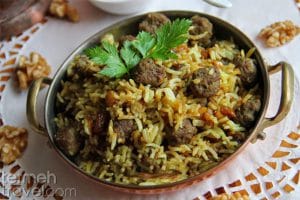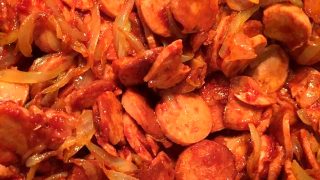Persian Khoreshts (Khoresh) is the delicacy of Persian cuisine. Having Khoresh or stew next to rice on the table is a match made in heaven. You can see how the gorgeous stew gives its shiny color to the white seeds of Persian rice and makes it more appetizing. Although both rice and Khoresh are delicious individually, when you place the layer of aromatic Khoresh on top of rice or Tahdig, your dish gets thousands of times better in flavor and taste. Generally, Persian Khoresh is a combination of vegetables, meat, and sometimes legumes, which is highly nutritious and mouthwatering. But the real magic happens when you add the Persian spices and see how the taste of Khoresh engraves in your mind.
Table of Contents
What Does Khoresh Mean?

According to Dehkhoda, the word “Khoresh” comes from “Khordan,” which means “to eat.” There is no specific information about the origin of Khoresh. However, you can find this word in some of the old Persian poems, such as Naser Khosrow’s works.
Since Iran is blessed with diverse weather and fruitful soil, each part of the country has its own variety of ingredients. Therefore, Iranians choose the ingredients of their Khoresh based on their environment. Although the recipe for different types of Khoreshs is the same in different parts of the country, there might be slight changes between them.
What Is the Difference between Khoresh and Stew
Linguists believe that people of a language come up with new specific words when something is valuable to them like Eskimos, who have different words for what we know only as snowflakes. In this case, in the Persian language, the stew translates to both Khoresh and Abgoosht, and the main difference between them is the way people eat them. Although the ingredients are similar, Iranians eat Abgoosht with bread, and serve Khoresh with rice.
What Are the Famous Persian Khoreshts?
People of Iran get super creative when they want to make Persian Khoreshts, so as a result, we have a wide range of Khorshes in Persian cuisine, which are aromatic, delicious, and nutritious. Therefore, learning how to cook these Persian Khoreshts can be a savior when you are wondering what to make for your family and friends.
Ghormeh Sabzi
The national dish of Iran is Ghormeh Sabzi, which has a special place in the heart of Iranians. This fantastic stew is a combination of herbs, like leek, parsley, chives, spinach, and dried fenugreek greens, along with red beans and meat. However, that is not all; the secret behind the pure deliciousness of Ghormeh Sabzi is the sour taste of dried lemon and cooking all the ingredients slowly to give you a shiny dark green look, which is blessed with the redness of beans.
If you want to learn how to make the most delicious Ghormeh Sabzi, check this recipe and enjoy the result.
Khoresh Bademjan or Eggplant Stew
Khoresh Bademjan is the true spirit of Persian cuisine. You need to cook this dish to see how combining sliced eggplants with meat, tomatoes, and saffron creates pure perfection. Compared to most of the Persian Khorshts, Khoresh Bademjan or Bademjoon cooks faster. So, if you are craving for a Persian dish but you have to consider the time, go for Khoresh Bademjoon. The aroma of saffron and the thickness of the liquid in the stew covers your rice, while the softness of the meat and eggplants melts in your mouth.
Khoresh Fesenjan
One of the most famous Persian Khoreshts is Khoresh Fesenjan or Fesenjoon, which is the main course of a classic Persian gathering. The best part about Fesenjoon is that you can adapt it to your taste. Therefore, if you are a fan of more sweet dishes, you can add more sugar to it. The favourite part of Fesenjoon stew is the texture of walnut and diced meat between your teeth. Besides meat (chicken) and diced walnut, what you need to have in order to make this amazing Khoresh is Pomegranate molasses. It brings the sweet and sour taste to our Fesenjoon and makes it unique.
Khoresh Karafs or Celery Stew
There is an ongoing fun dispute between Iranians about whether celery stew is delicious or not. If you ask me, Khoresh Karafs is one of the best stews that Persian cuisine offers to people. When the diced celery gets stirred with herbs and onion. And the saffron powder gives its fragrance to the stew, the result would be breathtaking. Then, for meat lovers, the tender meat gives its character to Khoresh Karafs and enriches it with its nutrients. The picture of the celery stew with a thin layer of oil is a masterpiece.
Khoresh Gheymeh
The royal of Persian cuisine is Khoresh Gheymeh or split peas stew. The taste of meat, split peas and saffron inside this stew is the reminder of food distribution in Muharram. Muslims of Iran make Khoresh Gheymeh and distribute it among people of their neighborhood to honor Imam Hussein. So, when Muharram comes, you can smell the aroma of Gheymeh from different houses and see everyone helping one another to make Gheymeh.
Khoresh Aloo Esfenaj
Spinach, golden sour prunes called Aloo Bokhara, and diced lamb are the main ingredients of Khoresh Aloo Esfenaj. This stew is similar to Ghormeh Sabzi in case of color. However, the taste is a combination of sour, salty, and sweet because of the sour prunes, which are like bonuses in your food. Spinach makes the liquid of your stew rich and gives it a perfect dark green color.
Khoresh Havij
Khoresh Havij or carrot stew might be the most underrated stew among Persian Khoreshts. The gorgeous orange color of the carrot combines with tomato paste and turmeric to look more vivid and shiny. If you are a fan of sweet food, you can add sugar to the stew and a little lime juice. Little pieces of lamb or chicken meat will absorb the taste of the liquid, and get more tender and yummy. So, if you are looking for new awesome food, go ahead and make this one.
Khoresh Loobia Sabz
Khoresh Loobia Sabz is made of diced green beans, onion, meat, tomato paste, and Persian spices. The most wonderful thing about this stew is the combination of color in it, which makes it a piece of art. But, the taste is another story because when you put the first spoon of this stew in your mouth, you feel the softness of green beans’ peels and the more chewy beans inside of it.
Khoresh Beh
Welcome to the Persian cuisine, where you can make a delicious stew made of quince, meat, onion, and tomato paste. The taste of Khoresh Beh or quince stew is moderated and desirable. Quince fruit is aromatic itself, so when you cook it with other ingredients, this aroma spreads and makes you stunned with the result.
Khoresh Anar
Another Persian stew made by an exotic Persian fruit is Khoresh Anar, that Iranians make with pomegranate seeds, chicken or duck, and a little pomegranate juice. This specific type of Persian Khoresh is more famous in the North of Iran, the heaven of traditional foods.
While eating the stew, you can feel the more resistant seeds that are covered with a layer of sweet/sour skin between your teeth. The unique taste of this stew makes your mouth water and gives you more desire to eat more.
Ghaliyeh Mahi
The magnificent stew of the South, Ghaliyeh Mahi, is extraordinary in taste and look. Before eating it, you can sense the garlic and tamarind, which plays with your heart. The first spoon of Ghaliyeh Mahi that you experience is a combination of tastes. So you can close your eyes and think about the soft fish, stirred herbs, garlic, tamarind and pepper which come together to make you fall in love with Persian Khoresh.
Khoresh Morgh o Aloo
One of the easiest Persian Khoreshts is chicken and golden prunes stew, which makes the chicken ten times better in case of texture and taste. So, if you are not sure what to make for dinner, you can always go with this option and cherish the result. You are totally free to add more or less water, sugar, and lime juice to this Persian stew and make it close to your preference. Therefore, you do not need to worry if the taste of prunes is too much for you.
Also, you can try this Khoresh with cherry plums if you want to go for a more sour taste. By replacing the chicken with lamb, you will definitely feel how delectable and tender your meat will be.
Khoresh Kangar or Spear Thistle Stew
No one expects to see a delicious stew out of this prickly plant. But Iranians could see the potential in it and cook one of the most wonderful types of stew. The fun and time-consuming part of making this Persian Khoresh is trying to clean the spear thistles and removing the pricks. When the hardest part is done, you can cook it with meat, spices, and tomato paste to have a gorgeous, tempting orange color.
Khoresh Khalal
One of the best Persian Khoreshts made with nuts is Khoresh Khalal, which is a perfect combination of sliced almond, meat, saffron, and dried barberries. Khoresh Khalal is originally from Kermanshah, a city in the West of Iran, people love to make it in their gatherings in that area. The appearance is impressive because of the sliced white almond and the vivid orange color of saffron. The taste also is quite moderated until the little dried barberries pop into your mouth and give you the pleasure of feeling the sourness of them.
Khoresh Bamiyeh or Persian Okra Stew
This delightful dish is one of the most unique and delicious Persian Khoreshts, which you can make with okras, meat or chicken, and tomato. You can make this Khoresh using diced okras or the whole vegetable. Although some people may not like the slimy texture of it, Bamiyeh can make your stew more thick and rich as well as nutritious.
You can also add okras to your Khoresh Bademjoon to find a delicious combination.
After getting to know different types of Persian Khoresh and how to make them, you can always travel to Iran to experience the authentic taste of these stews and meet the Iranian chefs who make them.
























Leave a Comment